#mathilde with an e
Explore tagged Tumblr posts
Text

Felt like sharing one of the best comments I've ever received. This was about my Jack and Phryne video. Forever humbled by people who take the time out of their day to write such wonderful things. I love fandom.
youtube
#miss fisher's murder mysteries#jack x phryne#phryne fisher#phryne x jack#fanvideos#fanvid#fandom#mathilde with an e#ao3#archive of our own#essie davis#jack robinson#nathan page#Youtube
108 notes
·
View notes
Text
BELGIUM - Frédéric Van Espen, Claude Noterdame & Alain Tholl de l'Enclos
Starting with the current Queen's hairdresser, Frédéric Van Espen steppend into the position in 2013, just before she became Queen of the Belgians, and has been styling her for national and international events since then. He has also worked with Elisabeth and Eléonore.


He's the owner of Didier & Rosalinde hair salon in Brussels, but he usually works wiith Mathilde in the private quarters at Laeken Castle. Looking at the website and portfolio you can see the similarities of his other works and what we've seen on Mathilde for a while:

I found an interview on the occasion of his 10th anniversary as the Queen's hairdresser where Frédéric gave a lot of detals of his work with Mathilde, even how it all started (second link below). According to what he said to HLN he's good friend with Edouard Vermeulen at Natan and he recommended him to Mathilde's team because her previous hairdresser was quitting.
His very first work was for Willem-Alexander's enthronement events, a tiara event to launch his career as the Queen's hairdresser, and not a simple gala, but an event for history books. I gotta confess that even if it's not an updo, Mathilde's hair on the day of the entronement it's one of my fave looks on her and I do see a change in style from the previous years.



Frédéric talked about how sometimes is dissatisfied with his work and that he notice little mistakes and is concerned about the outcome but that Mathilde reacts light-heartedly with a "Oh, that happens!" and I think that's the most on-brand Mathilde.
He also stated that when there are public events, he styles Mathilde at 7AM at Laeken, but on the occasional time, she goes to his salon and they have a private box for high profile clients such as her or, surprise, Prince Laurent. Frédéric also talked about when there's a state visit or during national day, he goes to the palace several times because everytme Mathilde changes clothes, he match the hair with the outfit, or when there's a trip abroad, he works on the plane in the stewards cabin without a mirror (talk about trust).
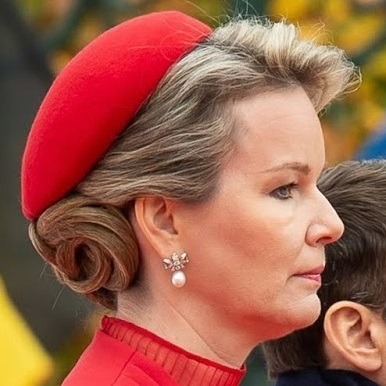

While he talks about what Mathilde likes, he says that she likes to stick to her classic style, but that Elisabeth now that she came of age give him more room to experiment. This interview was made 2 years ago, and I can't assure that he always does Elisabeth's har, but because she isn't a full-time working royal and her events are pretty limited, it's pretty safe to say that he's the one behind her two tiara appearances.


And I don't want to end this post without mentioning Paola's two known hairdressers: Claude Noterdam and Alain Tholl de l'Enclos. While Alain is also mentioned as her hairdresser, my guess from what I actually found, is that Claude was her main hairdresser for about 40 years. He was the owner of Maison Roger in Brussels and in 2016 he stepped down handing the salon to Alain and that's why he is also mentioned, because of the conection to Maison Roger.
Claude Noterdame started working with her when she was newly engaged to Albert, so he was the one behind those big updos we all liked (because we do agree that she had the best hair of her generation of Queens, right?)


He said that she visited his salon at least once a week, but when she couldn't he went to work at Belvédère Palace. He also accompained her to visits to the United States of Lebanon.
I actually found a small interview that RTL did in 2017 with Claude where he shows an archive of pictures of her updos that I would kill to see for myself and he also keeps pictures of a young Claude with Paola in different gatherings. It's in french and I understand just a little bit. Here it is in case you want to see those pictures and him talkng for 5 minutes:
Of course there's less information about the older generation's hairdressers, or at least is harder for me because of the limited resources in languages I don't speak (you should see me translating the dutch interviews hahaha). But at least there's something to offer you in these series of royal hairdressers.


To close this belgian edition,, I found a few titbits about Alain: he also styled Mathilde (probably before Frédéric came into the picture in 2013) and Princess Claire. He also works with Princess Laurentien of The Netherlands and both ladies usually have their hair done like any other client in the salon. He also stated that when they're in Belgum, he styles Princesses Marie Astrid and Margaretha of Luxembourg and Hereditary Grand Duchess Stéphanie.
Sources: x x x x x x
#royal hairdressers#belgian royal family#queen mathilde#princess elisabeth#queen paola#frederic van espen#claude noterdame#belgium
63 notes
·
View notes
Note
what are some of your favorite queer indie comics?
OOH! Off the top of my head in no particular order:
To all the White Girls I've Loved Before by Sarula Bao
Crimes by Kelsey Wroten (tho I also love Cannonball)
Shattered Spear by Otava Heikkilä (tho I also adore Sasha from the Gym and I will be reading Home By The Rotting Sea)
When I Arrived At the Castle by E. M. Carroll (tho anything Carroll does I'm a huge fan of and I desperately want to have a hardcopy of their new book A Guest In The House)
Love Condemns Her by Hana Chatani
Wrecked Hearts by Mathilde Kitteh and Luca Oliveri under Peow Studio (some of the stories are hit and miss but the general vibe of space romance inspired Lunar Boy, so it has a soft spot in my heart for that).
Boyish Anthology (butch x butch anthology! Hit and miss stories as most collections tend to be, but the ones that hit are so good especially when butch characters and butch x butch pairings are abysmally rare in sapphic spaces)
Of Thunder And Lightning by Kimberly Wang
Itching, Inching by Arantza Pena
Heat by Jean Wei
In Fair Verona by Val Wise (tho I'd pay attention to anything Val does tbh they're all gold)
Two Gay Little Animals Share Their Secrets by Anatola Howard (I love the You Were My Joker Last Night comic too)
Sacred Bodies by Ver
I don't doubt I'm forgetting some comics that I'll be devastated I didn't bring up here but!! These comics. I love them. Indie comics really scratch that itch where most mainstream publishing can't ever replicate.
#askjesncin#most of these are from sb comics fair but others are just random stuff I bumped into#i highly recc looking into the weirder queer comics scene because a lot of it is what people are asking for in mainstream spaces
57 notes
·
View notes
Text

Day 13: a rare pair
📚 Licurici by @lou-isfake
Draco/Harry/Charlie, wordcount 133k, E
Summary:
Charlie wanted Harry, but he’d never planned on having him. He’d never planned on Draco Malfoy, either. He hadn’t planned on anything but living out his days in Romania, with his friends and his dragons and his safe, peaceful distance. Apparently, it wasn’t a very popular plan. This is a story about crumbs and flickers and roots, running away and coming home; about falling in love without meaning to (twice), and having truly good friends, and the mutually revealing recognition between two people in love with the same man.
Licurici (m) Noun, Romanian (pl licurici) - Firefly (pronunciation here!)
🐲⚡🦗
One thing you may or may not already know from my previous recs, I love, ADORE, a good poly fic and I have to say Licurici is at the very top of my list. I wasn't sure about this pairing at first, because I am a very hardcore Drarry shipper, yet this fic has demonstrated beutifully how freaking deliciously Charlie just makes sense in this dynamics. He is the calm they need, the experience, the wilderness, the absolute devotion and acceptance. He is somehow exactly what both Harry and Draco need and I just... *melting*
There are quite a few aspects that make this story exceptional, let me enlist just a few:
Charlie being an empath (!)
while Draco is an excellent Occlumens (the angst!!)
THE DRAGONS! I would die for Mathilde. I kept imagining her as Hiccups from "How to train your dragon" and I couldn’t help falling in love with her 🐉🖤
the fact that the Malfoy grounds are being repurposed for a dragon sanctuary – as in, a place of healing and safety and DRAGONS
Charlie coming home. Not a lot of works out there describe that and I absolutely loved this aspect of the story.
Last but not least, big shoutout to @phoenixortheflame who has done a stunning bind of this fic with @saijordison Challengers-inspired art on the cover no less <3
Thank you for this lovely prompt @hprecfest and of course dearest @lou-isfake for your captivating fiction 🤍
Please find a few of my favourite moments of the story for your enjoyment under the cut
Molly explaining that traids are actually common and respected in the magical world !! I LOVE this concept. And then!
"King Arthur, Merlin, and Morgana? No?” She huffed and rolled her eyes. “The Founders of Hogwarts—did you think they were colleagues?”
All the Merthur and Mergana feels from BBC Merlin haha <3 Also all the „what do they teach in school these days” vibe, oh man, Molly <3
2. All the Draco = dragon jokes <3
"Speaking of dragons - where is Draco?"
"I have to tend to the other dragons,” he said with a wink, and Draco rolled his eyes, fighting a smile"
oh baby 😭
3.
"Love is not a limited resource"
*CRIES*
4. Charlie PERFECTLY summing Harry up in two words:
„Adorable and invincible”
I just love this boy 😍
5. Harry "conducting the electricity between them" which is the hottest and also most fitting description of their relationship at the time.
6. I am a complete sucker for situations where the third person is simply needed, like, logistically. So when Harry does his Auror stunts and Draco needs Charlie to take care of him or when Harry is in Mungo's and Draco needs Charlie there – I AM MELTED INTO THE GROUND.
7. Oh and the sex. I mean, phew, oh boy, these scenes were just SO HOT.
OKAY NOW MY FAV PART: Freaking Draco/Charlie dynamics.
I have a soft spot for the less obvious relationship in the triad, between „the others", so to say. Because Harry and Draco – that's just natural. Harry/Charlie – as we get Charlie's POV that’s also somehow... just makes sense. But Charlie and Draco – now, that's new.
At first, it seems that Harry – and their love for him – is the only thing they have in common (as beautifully illustrated in the Final Battle scene). But as the story progresses, we learn Draco's POV, we can see his "soft belly", we see Charlie falling for him and for Harry AND Draco's feelings. So once we are at this moment in the story, Harry basically just became a (cery pretty) ornament in this relationship for me 😅 And I LOVED how it was portrayed, how Charlie and Draco MAKE SO MUCH SENSE IF THEY JUST LET THEMSELVES TO.
#hprecfest2024#hprecfest#licurici#lou-isfake#louisfake#traid#poly ship#rarepair#or raretriad#but lets face it all triads are rare#and why#WHY#hp#harry/draco/charlie#drarry#or#drarry+#hihi#my recs#my stuff#froidefille recs
41 notes
·
View notes
Text

Procedimento di impeachment contro Macron. La motivazione: "Non vuole mollare il cadreghino"
Procedura di impeachment contro il presidente francese Emmanuel Macron. Lo ha annunciato il capo della fazione parlamentare del partito di sinistra, Mathilde Panaud. Secondo lei, la ragione di questa decisione è stata il rifiuto di Macron di riconoscere effettivamente i risultati delle elezioni nel paese.
La proposta di una risoluzione di partecipare alla procedura di impeachment del Presidente della Repubblica, conformemente all'articolo 68 della Costituzione, è stata inviata oggi ai membri del parlamento per la firma congiunta. Macron respinge i risultati del voto popolare, quindi dobbiamo licenziarlo. Fonte
Ora Macron respingerà anche il procedimento d'impeachment naturalmente, dopo essersi messo un mantello di ermellino, uno scolapasta in testa e urlando: "Le Roi c'est moi!!"
Per calmarlo dovranno intingerlo nella Senna.
Segui ➡️ 🌐 t.me/ArsenaleKappa 🅰️ 💥💥
ㅤ
11 notes
·
View notes
Text
When politics gets involved in history (French Revolution part)
As a general rule, when politicians meddle in history, it often creates confusion. Today I will talk about how they handle the French Revolution.
Of course, Jean Jaures did a good job on this period, although there are naturally points to criticize. But generally speaking, our politicians allow themselves to make crude or inappropriate remarks.
There are even serious historians who fall into the trap by making political amalgamations. A few days ago, while doing research, I came across an excerpt from an article by Thierry Lentz, a respected historian, made comments in Le Figaro comparing the left-wing opposition party, France Insoumise, to the Hébertists, labeling them as vulgar. My intention on this page is not to promote France Insoumise, but to qualify the Hébertists as vulgar (I imagine he also includes the Cordeliers and the Exagérés) is not good for me (the only thing that can be qualified as vulgar is the newspaper Le Père Duchesne and Hébert's style). Moreover, what does he mean by the left's reinterpretation of the Terror? He talks about Marxist-Leninist dogma in his terms, but Lenin preferred Danton, who was not a Hébertist. Plus the Bolshevik revolution was not based on the same principles as the French Revolution. The French Revolution has democratic aspects that the Bolsheviks did not apply (I'm not saying this to denigrate gratuitously the USSR, which became Russia, let's be clear). A country that has undergone a revolution compared to another country doesn’t necessarily adopt the same principles (often because there are different contexts, different paths, etc.). And reducing the Hébertists, Cordeliers, or Exagérés to the Terror is quite reductive (I have already expressed my thoughts on the Cordeliers in one of my posts).
Moreover, in left-wing parties, from what I have observed, it is rather the character of Babeuf that is taken up, considered as the father of communism (I once met a communist who saw Momoro as a reference and another who prefer Marat), while France Insoumise is something else (we can rather place Robespierre in the radical left, but I don't think he would have been a socialist, and we can be sure he was not a communist). So why once again Thierry Lentz associates France Insoumise with Trotskyism and Marxist-Leninism for taking up Robespierre? I mean, okay, there were communists who admired Robespierre like Stellio Lorenzi, but clearly not as many as one would think.
While Lentz's expertise in French history is widely respected, such political analogies raise questions about the neutrality of historical interpretation.
Moreover, it is interesting that the fact that "La Caméra explore le temps" rehabilitated the Montagnards led to the end of the program because of the Gaullist government. Once again, politics gets involved in history and leads to very bad results.
Now it's President Macron's turn. With Stéphane Bern, the president started to explain that an edict signed in 1539 by François I imposed French as the sole language in France. However, historian Mathilde Larrère says it was the French Revolution that imposed French as the sole language on the French. Once again, politics in history can lead to bad results.
I won't even talk about certain elements of the far right who claim to be followers of Robespierre because that would be giving them publicity, and it's not my vocation.
Now let's move on to Mélenchon from the France Insoumise party, who also made significant historical errors during this period. First, in one of Robespierre's videos, he calls Marie Antoinette a "spoiled brat." Accusing the former queen of treason I understand, she gave all the information she could to the enemy, but when you hear "spoiled brat," you're passing a value judgment that has nothing to do with it. Finally, he invents a marriage of Pauline Léon, saying that she ended her life in bourgeois fashion with a Girondin.
Moreover, Melenchon explain that the extreme left of the time was manipulated by the corrupt who arrested Robespierre. Okay, there were Billaud-Varennes and Collot d'Herbois in the mix, but you can't tell me that the Plaine was part of the extreme left. Moreover, most of the elements of what was called the extreme left were either in prison, like Claire Lacombe, Pauline Léon, Jean-François Varlet, or eliminated, like Chaumette, Momoro, Ronsin, and Hébert at the time of 9 Thermidor.
Moreover, contrary to what Mélenchon suggested, Chaumette and Hébert were not part of the Enragés movement.
In the end, this is the problem when our politicians try to shape history to fit their agendas. It leads to significant inconsistencies and inaccuracies.
21 notes
·
View notes
Text


Louis Aleksander von Liechtenstein
Ex-Príncipe Herdeiro. Filho da Dinastia. Forasteiro por escolha.
Data de nascimento: 10 de fevereiro de 1996 – Vaduz, Liechtenstein. Filiação: Filho primogênito de Johannes II, Príncipe Soberano de Liechtenstein, e da Princesa Consorte Mathilde von Sachsen, educadora e historiadora de renome europeu.
País de origem: Liechtenstein um pequeno, distante e real principado europeu, ainda governado por uma dinastia tradicional.
ABOUT
Educado segundo os moldes tradicionais da realeza, Louis nasceu em um pequeno país europeu que o resto do mundo mal recorda no mapa. Cresceu cercado por luxo, disciplina e um futuro meticulosamente desenhado antes mesmo de deixar o ventre da mãe. Desde cedo, demonstrava aversão às formalidades, à rigidez dos protocolos e aos discursos decorados.
Filho do soberano, cresceu com três irmãos, mas guarda poucas memórias afetivas da própria infância. Seus dias eram tomados por uma rotina exigente: aulas de latim, esgrima, economia, história dos Habsburgo e comportamento político. Aos 16 anos, foi enviado para um internato na Suíça — mais uma tentativa frustrada da família de moldá-lo aos padrões esperados.
Aos 18, vieram as primeiras tatuagens, escondidas sob a camisa. Em Oxford, formou-se em Ciência Política, mas abandonou o mestrado em Relações Internacionais antes da tese, trocando a academia por um impulso artístico: abriu uma galeria de arte em Berlim, encerrada em menos de três meses após ordens discretas do pai.
Fluente em alemão, francês, inglês, italiano — e em sarcasmo puro —, Louis começou, aos 21 anos, a publicar crônicas sob pseudônimos em jornais alternativos. Seus textos, ácidos e melancólicos, refletiam sobre o poder, a solidão e os laços familiares. Aos 25, após anos de atritos silenciosos e confrontos velados, assinou sua renúncia formal à linha sucessória. O documento, classificado como confidencial, repousa hoje nos arquivos secretos da dinastia.
Com a renúncia, recebeu uma herança particular, cercada de cláusulas restritivas:
Nunca poderia declarar publicamente sua ligação direta com a monarquia.
Nunca mais poderia entrar no território do principado sem autorização expressa do soberano.
A comunicação com os irmãos e a mãe foi oficialmente "desencorajada", o que, com o tempo, transformou-se em um silêncio quase absoluto.
Atualmente, vive sob o nome Louis Aleksander, sem títulos, sem escoltas, sem hinos. Escolheu o exílio voluntário em uma cidade quase anônima pra sua familia, onde ninguém o conhece de verdade e onde, segundo ele, ninguém precisa conhecê-lo para deixá-lo em paz.
Durante o dia, escreve sob o pseudônimo “L.”, assinando crônicas quinzenais que transitam entre filosofia de bar, crítica social e reflexões sobre perda. À noite, trabalha discretamente em um pequeno café-restaurante, mais por aparência do que por necessidade.
Louis é um homem que abriu mão do trono, mas não da palavra e é através dela que ele, enfim, reina.
Relação com os Pais
Johannes II: Frio, imponente, devoto ao dever e à imagem da monarquia. Com Louis, a relação era mais bélica do que paterna. Louis o admira… mas jamais quis ser ele.
Mathilde: Rigida, triste, doce e infinitamente decepcionada. Ela o amava em silêncio, mas sempre escolheu a coroa. A maior ferida de Louis talvez seja essa.
Sobre amor e outras drogas.
Louis Aleksander nunca entendeu o amor como uma coisa leve. Ele sempre se envolveu com pessoas intensas, quebradas, artísticas. Amores que duravam o tempo exato entre um copo de vinho e uma tatuagem nova.
Relacionamentos ou quase isso?
Adelheid von Bismarck - ex noiva
Filha de diplomatas alemães. Bela, impecável, estrategicamente ideal. O casamento foi arranjado quando Louis tinha 23 anos — um acordo silencioso entre casas reais que ainda fingem viver no século XIX. Adelheid não era cruel. Só era… funcional. Eles tentaram. Realmente tentaram. Por alguns meses, houve jantares, viagens, aparições públicas e um quarto trancado cheio de silêncio entre eles. Louis a respeitava, mas não conseguia tocá-la sem sentir que traía a si mesmo. Ela, com a paciência educada de quem foi criada para engolir vontades, fingia não notar. Duas semanas antes do anúncio oficial do noivado, ele desapareceu por cinco dias. No sexto, ele voltou para Vaduz, entregou a carta de renúncia ao pai, e nunca mais a viu.
EXTRAS
Apesar da aparência de ex-boêmio falido, Louis é absurdamente rico. Sua herança privada, deixada por um fundo da família materna, inclui: Propriedades na Suíça, Áustria e no norte da Itália. Aplicações milionárias em fundos europeus. Acesso a obras de arte, joias, investimentos silenciosos.
Desde que renunciou, Louis é caçado por paparazzi.
Não acredita mais em “pra sempre”, mas sente falta de dormir ouvindo outra respiração.
Não se permite ser cuidado, mas tem medo de morrer sozinho.
Louis fala baixo, exceto quando está irritado ou bêbado.
Não suporta relógios. Não usa, não tem, não quer saber das horas. Diz que "tempo demais o controlou".
Sofre de insônia desde os 17. Dorme no máximo 4h por noite, geralmente no sofá, ouvindo música antiga no vinil.
Vive com a sensação constante de que é observado e não está 100% errado.
Tem mania de mexer nos anéis quando está ansioso. Um deles, escondido no fundo da gaveta, era da mãe.
Ainda tem o sotaque europeu nobre, mas disfarça nas conversas casuais.
Ele ainda se lembra do perfume da noiva. Evita passar por vitrines de lojas caras por causa disso.
Não acredita em casamento. Mas acredita em almas que se reconhecem. E isso o assusta mais.
Tem uma tatuagem no peito com a frase "Nascido para outra vida", escrita em latim.
Seu artista favorito é Egon Schiele, ele diz que os corpos tortos e belos o representam.
Canta bem, mas ninguém sabe. A não ser a ex-noiva.
5 notes
·
View notes
Text
with my fingers burned, I start anew: A Lady of Autumn One Shot.
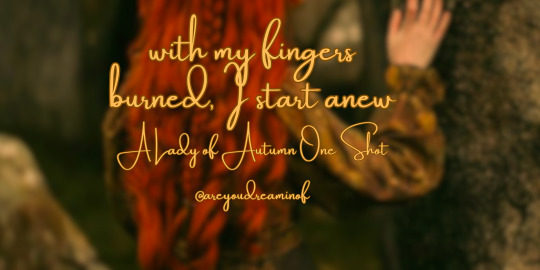
“Come on!” she heard a giggle on the wind. She turned her head, the movement slow as she took in the deep green and bronze of the trees surrounding her. These oaks and junipers meant they were still in Autumn, but the borders of Summer.
She had not been to these woods since she was a girl. She was dreaming, then.
She searched ahead for the voice when she heard it again. “You’re being too slow! We must get going!”
She knew that voice, and she knew the deep auburn hair and the golden bow. Mathilde waited for her under a juniper tree. Fearless and wild Mathilde, her older sister. She gasped as a ruddy cheeked young girl, with bright copper hair, approached her and grabbed her hand. Her younger sister, Delphine met her eyes, more golden than her own. They were women when they died, she thought absently, and now they came to her as younglings again.
“Thérèse, hurry!”
Her heart skipped a beat, threatening to wake her. She had not heard her name in centuries.
Where are we going? She tried to ask, but she could not speak. So instead she ran with her sisters. Mathilde led the way as she used to, her hair a deep red sheet behind her. Delphine never let go of her hand as they ran ahead. The trees thinning, green threading through oranges and brown. She was moving, but she could not feel her feet touch the ground. If she had any doubts she was dreaming, they ended there as she seemed to leap across the forest floor. Mathilde slowed to a stop, approaching a path carved between rows of aspen trees, sunlight filtered through their golden leaves, their white trunks stretching high.
“Thérèse, you’re too far behind. We’ll never make it.” Mathilde scolded, Deplhine tugged her hand, as she whispered, “It’s time to go Thérèse.”
She was Wife, she was Lady, she was Mother. But she had not been Thérèse in a very, very long time.
Continue on ao3
taglist: @acourtofladydeath @autumndreaming7 @asnowfern @bagelfyre @c-e-d-dreamer @foundress0fnothing @goddess-aelin @hugeclearjellyfish @itsthedoodle@kataravimes-of-the-shire @krem-does-stuff @lidiacervos @labellefleur-sauvage @melting-houses-of-gold @melphss @mossytrashcan @popjunkie42-blog @panicatthenightcourt @reverie-tales @spell-cleavers @sassyhobbits @separatist-apologist @secret-third-thing @thesistersarcheron @thelovelymadone @the-lonelybarricade @ultadverb @velidewrites @vulpes-fennec @ofduskanddreams @octobers-veryown @xtaketwox @houseofhurricane @ablogofsapphicpanic @iftheshoef1tz @damedechance @wilde-knight @fieldofdaisiies
49 notes
·
View notes
Text
Amy Castles - Angels Guard Thee (Berceuse) ('Jocelyn' - Godard) (1907)
“Amy Castles - The Bendigo Nightingale” -
From Melba: a biography by Hetherington, John, 1907-1974:
The pupil was the Australian soprano, Amy Castles, who was born in 1882 in the Melbourne suburb of Carlton, perhaps three or four miles distant from Melba’s birthplace in Richmond. She came under notice in Australia when only about sixteen, and, after raising £2, 000 for her studies abroad by giving a series of concerts in Melbourne, Sydney and other Australian cities, arrived in Paris in 1899. The only European singing teacher most Australians knew at that time was Mathilde Marchesi, who had put Melba into opera, and it was to the Ecole Marchesi that Amy Castles went— a wideeyed seventeen-year-old from the Antipodes, hoping she would impress the great teacher. To her delight Marchesi accepted her as a pupil. The results were all but disastrous.
Marchesi did not agree with Amy Castles’s Australian teacher, E. Allan Bindley, that her voice was a soprano; after a few weeks she was training the Australian girl as a mezzo-soprano, and after a few weeks more as a contralto. Eighteen months of Marchesi’s training nearly sufficed to destroy Amy Castles s voice, but just in time her mother arrived in Paris and made her leave the Ecole Marchesi and put herself under Bouhy. From London Melba, who had previously taken little interest in Amy Castles, sent a message to her saying in effect, ‘Unless you return to Marchesi at once you will never be heard of again.’ This was a terrifying threat from the unofficial ruler of Covent Garden, but Amy Castles stayed with Bouhy. He restored her voice but took some years to do it, and, although she made a concert tour of Australia and also appeared as a concert artist in London, she was not ready for grand opera until 1907. She made her debut in Hamlet in Cologne, and also sang there in two of Melba’s own favourite operas, Romio et Juliette and Faust. She was never called to Covent Garden, which astonished connoisseurs of the soprano voice who heard her at that time; the best of them believed her to be within measurable distance of Melba, if not quite Melba’s equal. Landon Ronald, who was then closely in touch with Melba, admired Amy Castles as a singer, but once told her, ‘You’ll never get to Covent Garden, you know.’ He did not ela¬ borate, but she interpreted his words as meaning that Melba was incurably hostile toward her. In some departments of singing Amy Castles was possibly Melba’s superior. The Australian critic, Thorold Waters, who said her voice ‘combined the attributes of a dramatic and coloratura soprano’, believed that the only tones re¬ sembling hers in quality ‘were the gorgeous ones of Emmy Destinn, but even that dramatic soprano’s exploits did not extend to coloratura flights’. Melba either never shared these opinions, or did not admit to sharing them.
Events did not bear out Melba’s poor opinion of Amy Castles. She never did scale the ultimate heights, but this was not due to any shortcomings either of her voice or the way she used it. In 1913 the Imperial Opera House, Vienna, gave her a five-year contract to sing Mimi, Butterfly, Desdemona, Marguerite, Juliette, Tosca, and other roles. She was doing well when war in Europe became inevitable and she had to leave Austria, abandoning her contract, and as it turned out her career as an opera singer in Europe. A woman dedicated to success would have waited for the war to end, then picked up her career where it had been cut short. Amy Castles had more than enough talent to re-establish herself, but by the time the war ended she had lost interest. She was a timid woman, with none of the driving egoism which was a strong ele¬ ment in Melba’s success, nor even much appetite for fame. She loved singing, and at her best sang magnificently, but she was as happy singing to the Castles family circle as to a great opera house blazing with diamond tiaras and snowy shirtfronts. Soon after the outbreak of war she went home to Australia to be with her ageing two of her sisters, Dolly and Eileen, and a brother, George, were also talented professional singers. None of them was in Amy’s class, but Eileen, a soprano, went abroad and made a small name in opera, and sang secondary roles at Covent Garden. Eileen was also a student of Jacques Bouhy, but Melba did not appear to hold that against her. She was perhaps influenced by the thought that Eileen Castles was a lesser soprano than her older sister, and never could be any kind of rival.
For all her unhelpfulness to Amy Castles, Melba always seemed to be busy, from the time she went back to London in 1903 until she retired nearly twenty-five years later, guiding the feet of one or another promising young musician along the slippery profes¬ sional paths. She was consistently helpful to young artists with the exception of sopranos having both voices and personalities of the highest quality. With her own reputation established and consoli¬ dated she had time to play the role of the supreme prima donna, off the stage as well as on it. A word from her was enough to assure a hearing in London for any young singer or instrumentalist. She was not infallible in separating the musical sheep from the goats, and many of those she sponsored were politely listened to, then allowed to sink back into obscurity. Melba never made a mistake in assessing the quality of a voice or the technical possibilities of an instrumentalist, but she often went wrong in estimating character, and that was why many of the young people for whom she predicted brilliant futures were forgotten within a few months of making a professional debut. Now and then, however, one of them produced the stuff of lasting success.
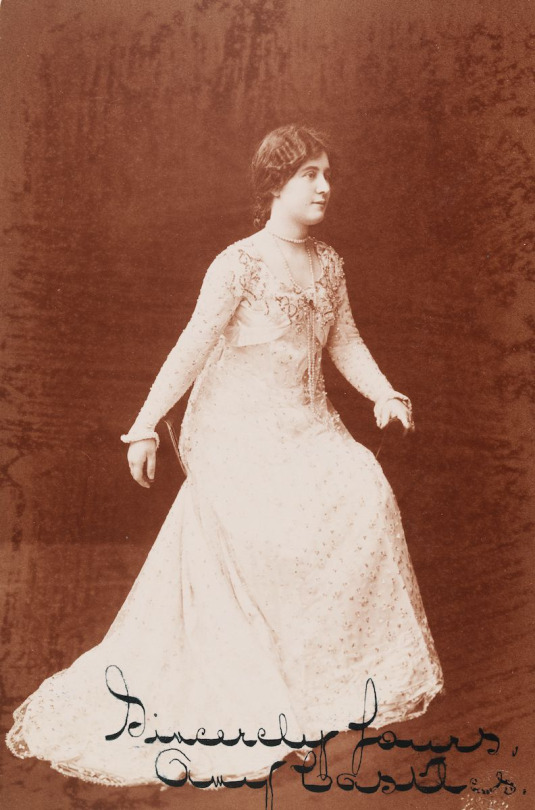

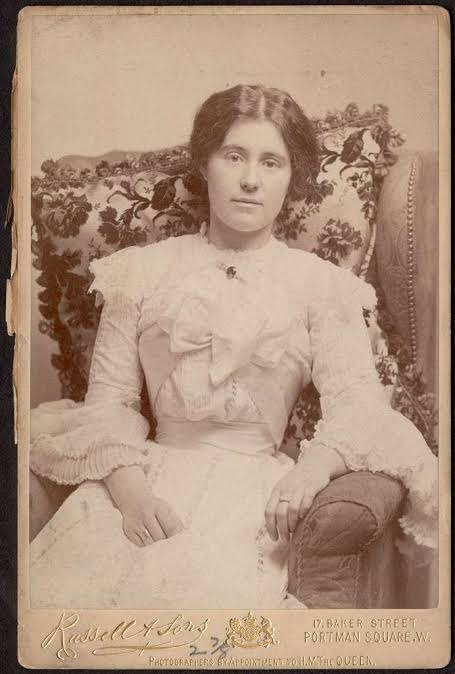
#classical music#opera#music history#bel canto#composer#classical composer#aria#classical studies#maestro#chest voice#dramatic soprano#soprano#The Bendigo Nightingale#The Nightingale#classical musician#classical musicians#classical history#history of music#musician#musicians#diva#prima donna#Carnegie Hall#Amy Castles#Covent Garden#Benjamin Godard#Jocelyn#Angels Guard Thee
2 notes
·
View notes
Text
Images of Geneviève Lantelme -
According to Wikipedia "Geneviève Lantelme (born Mathilde Hortense Claire Fossey, 20 May 1883[1] – 24/25 July 1911) was a French stage actress, socialite, fashion icon, and courtesan. Considered by her contemporaries to be one of the most beautiful women of the Belle Epoque and bearing a resemblance to American actress Ethel Barrymore, she is remembered for the mysterious circumstances of her death: on the night of 24/25 July 1911, she fell from the yacht of her husband, Alfred Edwards."
1902 (May issue) Lantelme in Paquin, Les Modes May issue. From verbinina.wordpress.com/page/8/ 2106X3000.

1902 Geneviève Lantelme, Théâtre du Gymnase, photo by Reutlinger, Les Modes July 1902. From les-modes.tumblr.com/image/51225719455; fixed spots w Pshop 1280X1779.

Genevieve Lantelme in Doucet by Reutlinger. From tumblr.com/beautifulcentury859X1600.
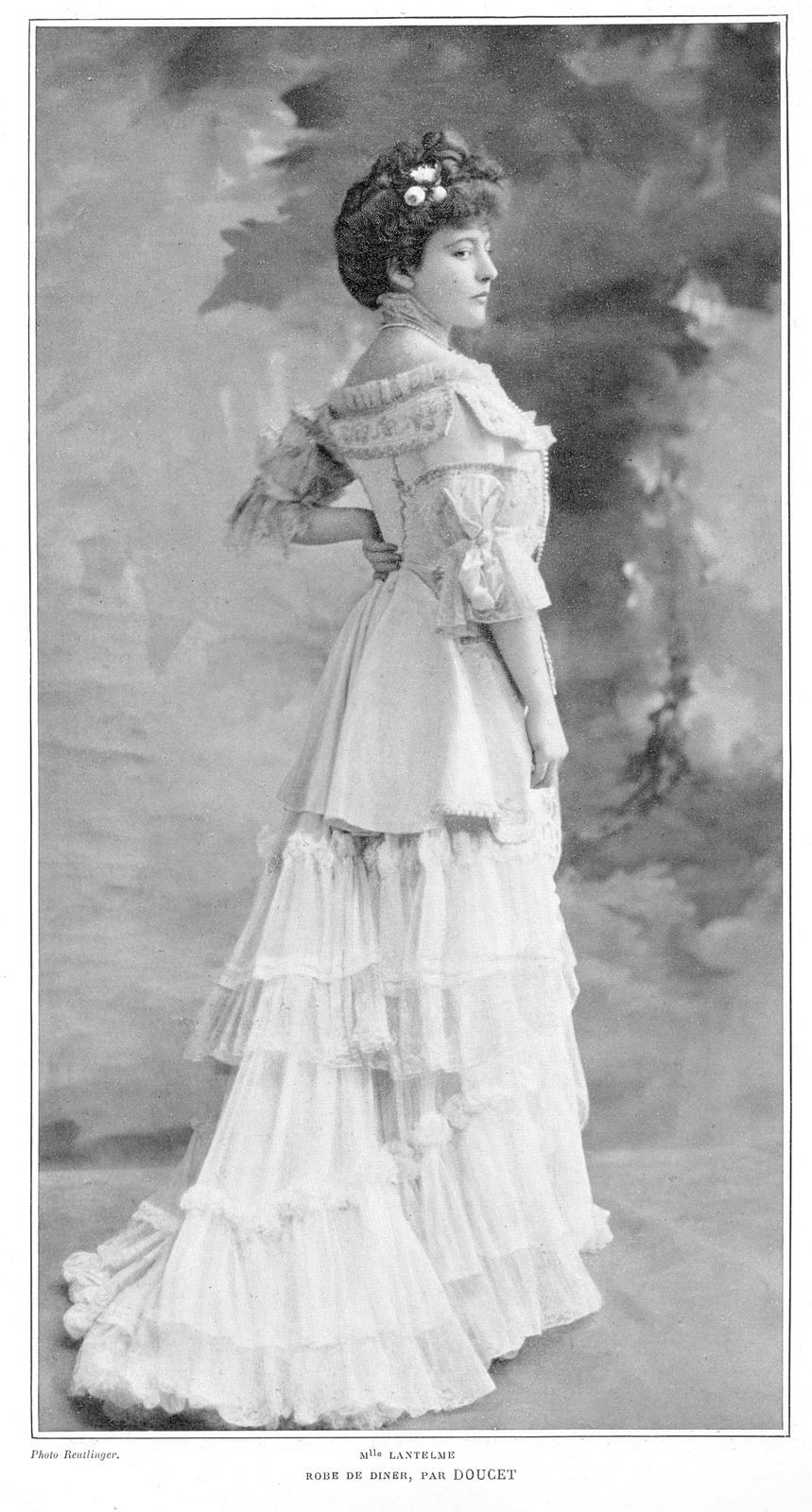
ca. 1905 Geneviève Lantelme by Henri Manuel. From Wikimedia 2283X2883.
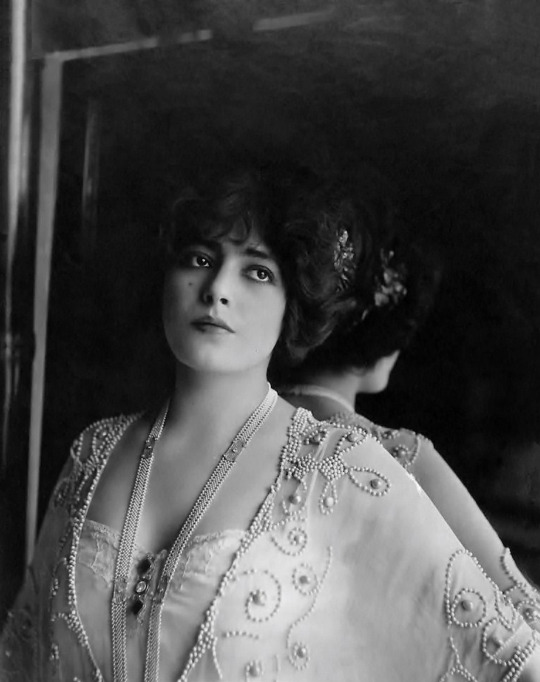
1907 Mademoiselle Lantelme by Giovanni Boldini (Galleria Nazionale d'Arte Moderna e Contemporanea - Roma, Italy). From Wikimedia 1474X2776.

1907 April Mlle. Lantelme of the Theatre Rejane with lace-trimmed celadon day dress, with pink roses and feathers in her red hair, wearing rings of white and black pearls, photographed by Paul Boyer, on cover of French periodical les Modes 853X1280.
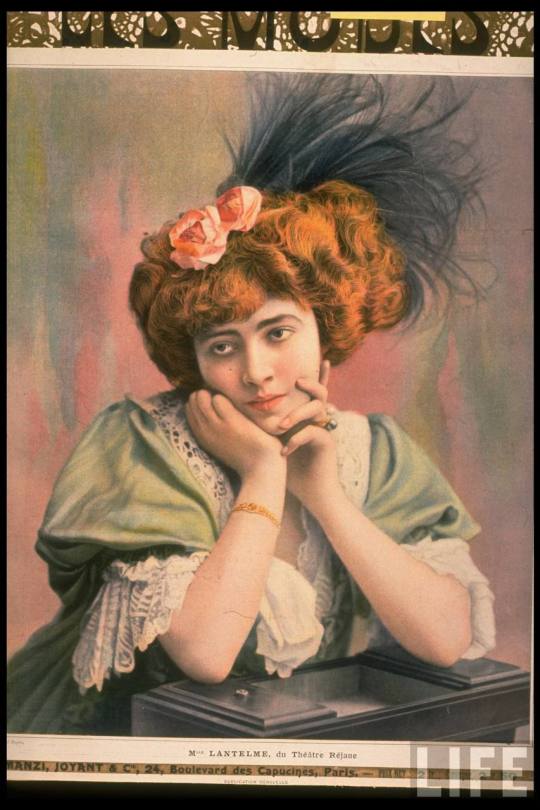
Lantelme in Paquin day dress by Félix. From verbinina.wordpress.com/page/6/ 1266X2806.

ca. 1908/1909 Lantelme in Vionnet gown by ?. From verbinina.wordpress.com/page/3/; fixed larger spots w Pshop 1280X1707.

1910 (June) Genviève Lantelme in Maison Drion-Régnier sheath evening dress, Les Modes - photo by Félix. From les-modes.tumblr.com/page/28 1280X1784.

1910 Geneviève Lantelme in Le Costaud des Epinettes by Abel Faivre (location ?). From Wikimedia 1190X1620.
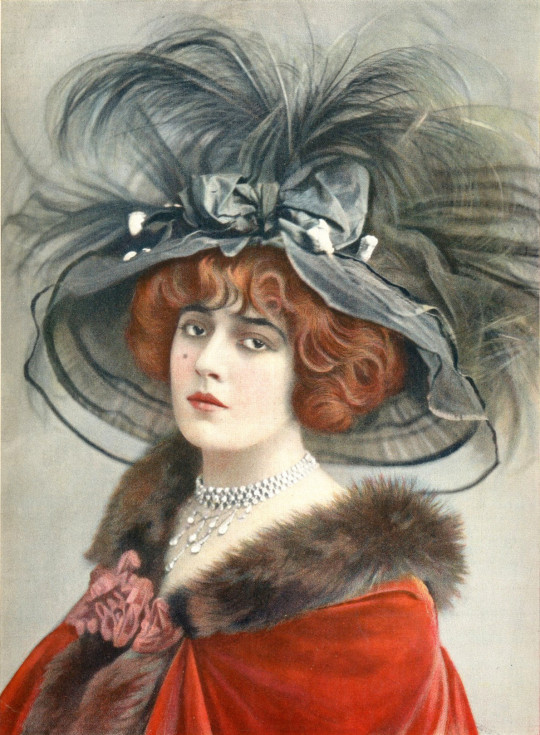
Lantelme in Paquin afternoon dress by Félix. From verbinina.wordpress.com/page/6/ 1789X2395.
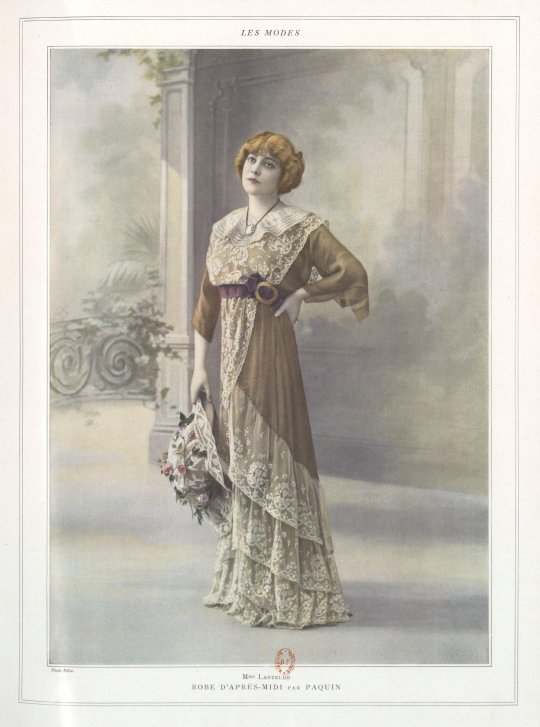
1910 Lantelme in Paquin photo Reutlinger. From verbinina.wordpress.com/page/6/ 2048X3060.
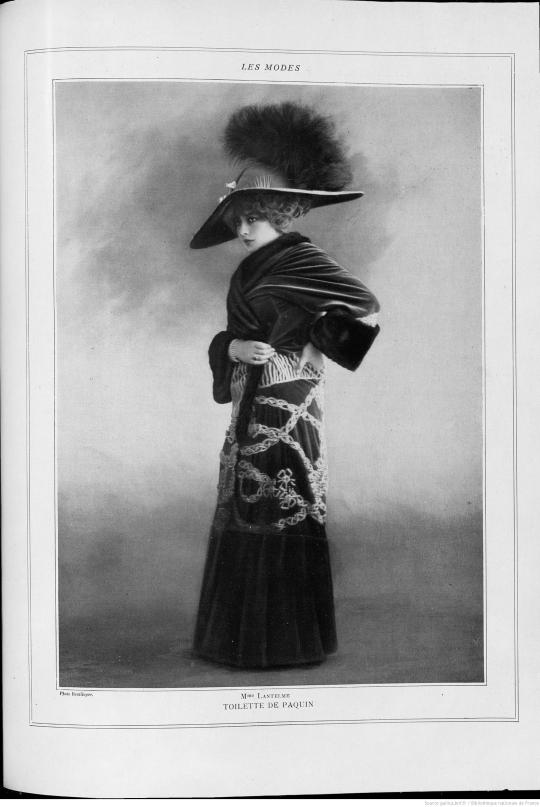
1911 Elegante et son chien (Lantelme with blue hortensias) by Antoon van Welie (location ?). From verbinina.wordpress.com/2015/03/06/an-unknown-portrait-of-lantelme/; doubled size 1600X1032.
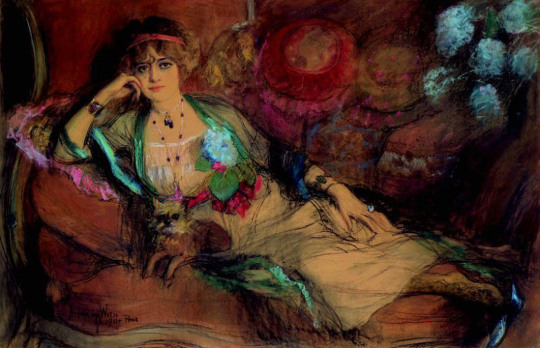
1911 Lantelme photo in 2 August 1911 issue of The Bystander. From verbinina.wordpress.com/page/2/; fixed spots w Pshop 815X1186.
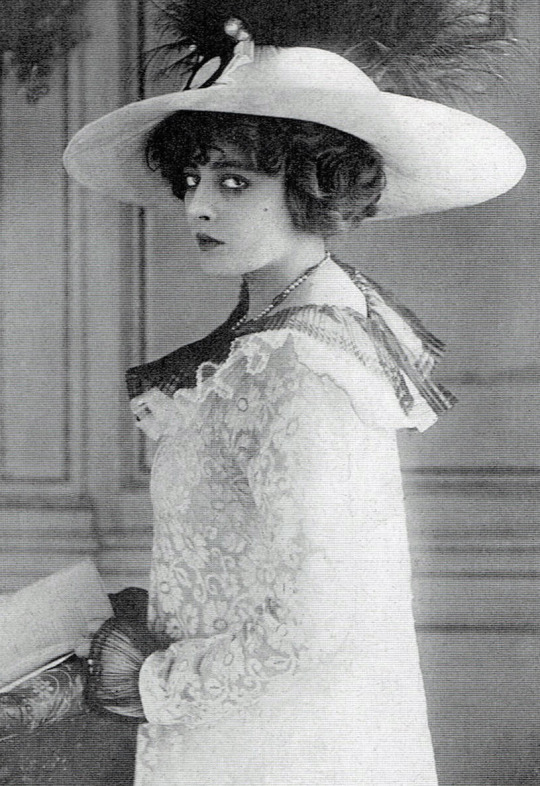
1911 Un Vendredi au Salon des Artistes français by Jules-Alexandre Grün (Musée des Beaux-Arts de Rouen - Rouen, Normandie, France). From verbinina.wordpress.com/page/7/; fixed spots & abrasion flaws w Pshop 4800X2800. Lantelme is at the visual center of this work.
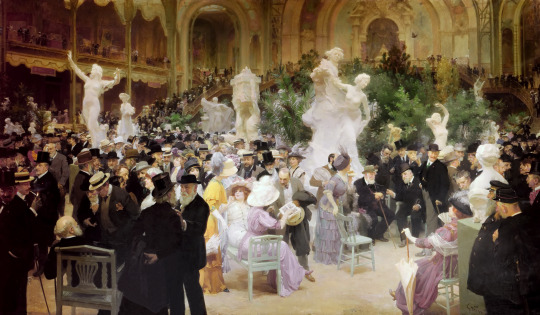
Lantelme and dogs by Reutlinger. From verbinina.files.wordpress.com/2015/06/lantelme-cabinet-photo-with-2-dogs; adjusted borders & fixed flaws w Pshop 1094X1594.

Lantelme in La Gamime wearing Paquin by Reutlinger. From verbinina.wordpress.com/page/6/ 1230X1636.
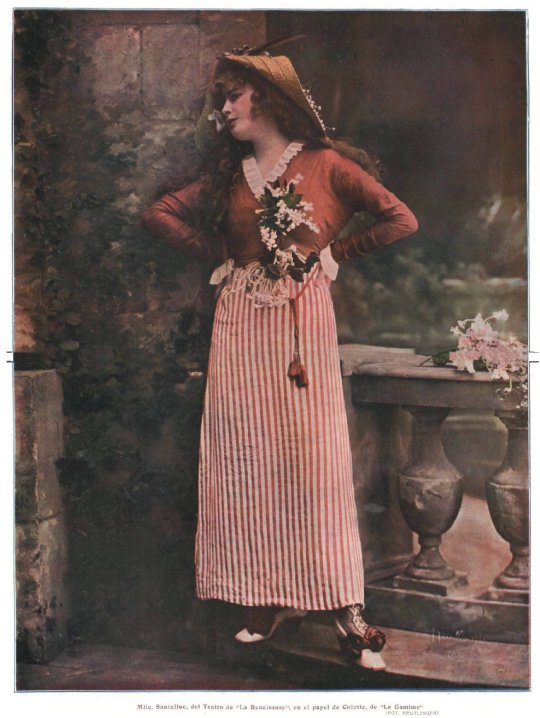
Lantelme in Paquin by Manue. From verbinina.wordpress.com/page/6/ 2197X3360.

Lantelme in Paquin. From verbinina.wordpress.com/page/6/ 1401X2000.

#Belle Époque fashion#1900s fashion#1910s fashion#Paquin#Jeanne Paquin#Jacques Doucet#Drion-Régnier#Madeleine Vionnet#Reutlinger#Félix#Giovanni Boldini#Abel Faivre#Manue#Antoon van Welie#Jules-Alexandre Grün
36 notes
·
View notes
Text

arpeggio
┕ cybernoir romance • 154k words • complete • rated E ┑
An ex-cop with a family to repair. An ex-corpo with demons and a death sentence. . . The grisly work at Edgewood is finished, but V and River aren’t done with each other just yet.

The Arpeggio jazz club straddled the seam between Japantown and Vista Del Rey, a cultural vortex where places like this still existed, hidden in the margins. Descending the stairs from the damp streets was like stepping through a tesseract into the last century. River had seen places much like it in old movies: smoke and longing thick in the air, blue lights, dim vinyl booths filled with strangers and their stories. . .
🔗 on ao3→

🏷️ related tags
#oc: valerie mathilde • #river ward • #otp: arpeggio
📸 vp & art
photoset by breezypunk
moody b&w shots
gotta live with a few question marks
🎧 playlist
#cyberpunk 2077#fanfiction#river ward#otp: arpeggio#oc: vmdbm#river ward x v#ao3#my writing#fic masterpost#oc: valerie mathilde#~
22 notes
·
View notes
Text
since doctor who is trending, lemme share the nine/rose tribute I made using studio ghibli music that youtube blocked
other videos here
#nine x rose#the doctor and rose#doctor who#russell t davies#rose tyler#billie piper#christopher eccleston#ninth doctor#tenrose#ten x rose#doctor x rose#timepetals#ninerose#mathilde with an e
380 notes
·
View notes
Text

Giovanni Boldini. Il pittore che amava le donne. Ritratto di Mademoiselle Lantelme. 1907. Galleria Nazionale d'Arte Moderna e Contemporanea, Roma (Italia).Geneviève "Ginette" Lanthelme (1887 - 1911), pseudonimo di Mathilde Fossey, fu un'attrice e cantante lirica celebre nella Francia degli inizi del Novecento. Spesso al centro delle cronache mondane, fu amante di Alfred Edwards, proprietario del giornale "Le matin", del "Petit sou" e del Théatre de Paris: fece parlare di sé anche a seguito della sua prematura morte, avvenuta per annegamento durante una crociera sull'imbarcazione "Aimée" di Alfred Edwards (cfr. Cecchi, 1962, pp. 214-15).Giovanni Boldini ritrasse l'attrice nel 1907. Un disegno della testa della Lanthelme compare nel catalogo dello "Studio di Giovanni Boldini" (cfr Cardona, 1937, op. cit.).Nel ritratto, l'attrice, vestita con un elegante abito della Maison Doucet, fa sfoggio della sua sfrontata bellezza messa in risalto dalla posa frontale, ripresa dal basso verso l'alto, e dalle dimensioni della tela che rendono la figura monumentale. L'opera è strettamente connessa al "Ritratto della Marchesa Casati con un levriero", di poco successivo (1908, collezione Andrew Lloyd Webber. Ripr. in Dini, 2002, vol. III, tomo II, n. 967): in entrambi i ritratti prevale il nero degli abiti, da cui emergono i toni rosati dei volti delle effigiate e degli elementi floreali all'altezza dei fianchi.Il dipinto, oltre ad avere tutte le caratteristiche del ritratto "à la mode" boldiniano, sembra ispirarsi alla ritrattistica dell'aristocrazia inglese del Settecento, in particolare quella di Gainsborough e Reynolds (cfr. A. Villari in Boldini, 2005, p. 240): d'altronde il pittore ferrarese, nei primi anni '70 dell'Ottocento, si era già cimentato in soggetti settecenteschi in linea col gusto di mercato allora imperante (cfr. R. Campana in Boldini, 2005, p. 117).Il dipinto fu acquistato dalla Galleria Nazionale d'Arte Moderna nel 1914 grazie all'intervento di Ugo Ojetti: l'opera si trovava in vendita al prezzo di dodicimila lire presso tale "Signor Manzi" della Galleria Manzi Joyant di Parigi, il quale, però, l'aveva acquistata per venticinquemila lire. La svendita dipendeva dalla tragica morte dell'effigiata (cfr. lettera al Ministero della Pubblica Istruzione, 1913, Firenze, Fondo Ojetti 250, BNC)
3 notes
·
View notes
Text

GVGP Profile: Albany Capp
Having finished what is, so far, the most verbose profile in the GVGP, we're moving on to something a tad more succinct. This time, we're covering the sim in this batch who fathered the most children -- Albany Capp.
Albany’s family tree shows that his ancestors were part of the “new blood” brigade. This means that, despite being counted among the fourth generation gang, he’s technically a third generation sim within his birth family. In terms of ancestry, Albany is the son of Richard and Anne Norman, as well as the grandson of William and Mathilde Norman, and Henry and Eleanor Anjou.
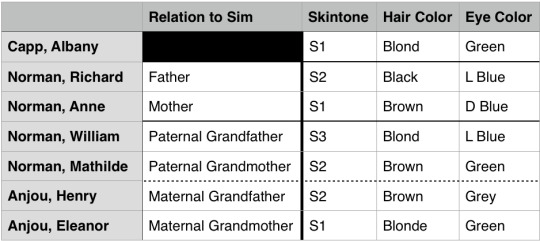
Albany Capp's Genetic Profile

Albany Capp's Visual Profile
Having fathered four children with his wife, Goneril, Albany will be present in each of his offsprings' genetic profiles, and will be given a mention whenever necessary.
Skintone
As the son of an S2 father and an S1 mother, Albany’s S1 skintone makes perfect sense.
Hair Color
Albany is the blond son of a black-haired father and a brunette mother. That said, the fact that blond(e) hair is present on both sides of his family tree means that Albany’s hair color makes sense, provided both of his parents had recessive alleles in their genetic codes.
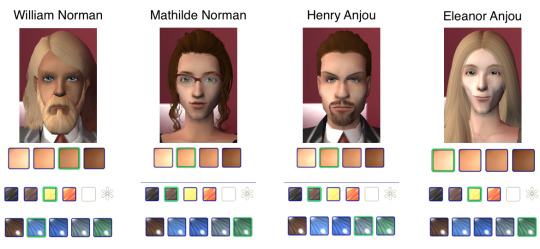
Albany's Grandparents
The source of the blond(e) allele among Albany’s paternal ancestors is William Norman, who passed his allele down to Richard, which was then passed down to Albany. As for his maternal ancestors, the source in this case would be Eleanor Anjou, who passed her allele down to Anne, which was then passed down to Albany.
Eye Color
Much like his hair genetics, Albany’s eye genetics skipped a generation. Unlike his hair genetics, Albany’s ancestors’ eye colors are almost all recessive, and the only dominant one doesn’t make any sense (*cough* Anne *cough*).
On both sides of Albany’s family tree, it’s his grandmother who initially carried the gene for green eyes. That said, because Albany’s family history is filled with recessive eye colors, only one of his grandmothers would have needed to pass the allele down to him. If, however, both of them passed it down, then Albany would be homozygous for the trait.
As a Whole
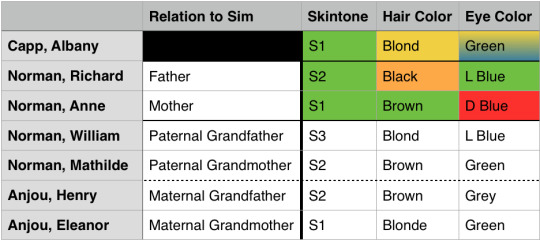
Albany's filled out genetic profile. His skintone makes perfect sense, while his hair and eye colors both make sense if we assume they just weren't expressed for a generation (this is in spite of Anne's faulty dark blue eyes, by the way).
Who's Next?
Having covered the final sim who married into the Capp family, our next entry will cover the final sim who married into the Monty family. Next time, we're going to look at the only deceased sim who hasn't been covered yet -- Hero Monty.
Thank you for reading!~ <3
#albany capp#veronaville#sims 2#sims#veronaville vault#great veronaville genetics project#gvgp#norman family
9 notes
·
View notes
Text
Thanks @floydsglasses for the tag 🩵
"You can tell a lot about someone by the type of music they listen to. Hit shuffle on your iPod, phone, iTunes, media player etc and write down the first 20 songs. Then pass this on to 10 people. One rule: NO SKIPPING."
Oh lord it’s gonna be wild-
1- THE DEATH OF PEACE OF MIND - Bad Omens 2- Jolene - Dolly Parton 3- Slow Down - Chase Atlantic 4- Mr Loverman - Ricky Montgomery 5- All of your lies - Morgan Clae 6- My Sails Are Set - Sonya Belousova, Giona Ostinelli, AURORA 7- You Make Me Sick! - Ashnikko 8- Beau Malheur - Emmanuel Moire 9- Qu’ils ont de la chance - Disiz 10- POUR CEUX - Younès 11- E A VERDADE - Rilès 12- How I’d kill - Cowboy Malfoy 13- Premier Amour - Nour 14- A la gloire des femmes en deuil - Mathilde 15- To The Boy - Kelly Muse 16- break my bones - Matt Hansen 17- Hollow - Victor Ray 18- What Was I Made For ? - Billie Eilish 19- Avec ta zouz - Therapie TAXI 20- Fictional - Khloe Rose
More French songs than expected-
I'm tagging blindly tbh : @ryebecca @attapullman @seresinhangmanjake @desert-fern @trickphotography2 @mothdruid @horseshoegirl @happypopcornprincess @southpawbitch @roosterforme
6 notes
·
View notes
Text

RANCÉ 1795 - MATHILDE - Collection Impériale - Eau de Parfum - Novità 2023 -
Eleganza e gentilezza d’altri tempi definita da un linguaggio olfattivo contemporaneo, ecco Mathilde, la nuova creazione di Maison Rancé 1795 per la Collection Impériale.
La fragranza è ispirata a Mathilde Bonaparte, nipote di Napoleone I, donna di carattere, amante delle arti, mecenate di artisti e letterati nella Parigi del XIX secolo.
Raffinato il ritratto odoroso che scaturisce da emblematici accordi floreali fruttati, narciso, iris, mughetto, gelsomino, rosa, vibrano nella sfumatura esotica di papaya e passion fruit e si impongono al desiderio e al ricordo nell’armonia finale di vaniglia, legno di sandalo, muschio.
Eau de Parfum 50 e 100 ml. Online qui
©thebeautycove @igbeautycove

2 notes
·
View notes